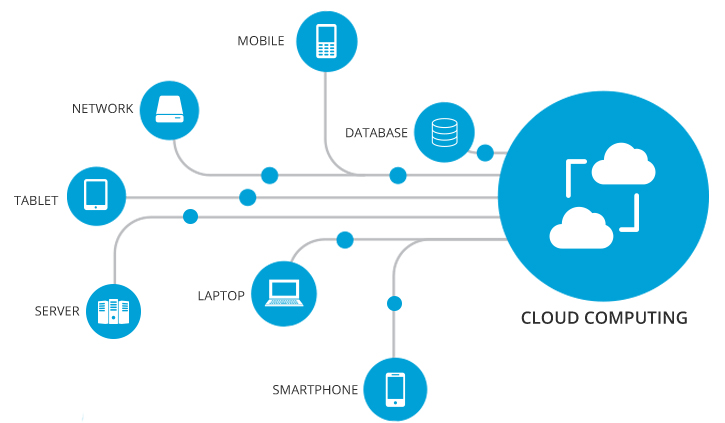Drive Development: Utilizing the Power of Cloud Services
In the fast-paced landscape of modern-day organization, using the power of cloud solutions has actually come to be an important element for companies aiming to drive innovation and preserve an one-upmanship. The capability to range resources dynamically, embrace innovative modern technologies perfectly, and simplify growth procedures successfully can dramatically impact a company's capacity to adapt and introduce. As we check out the elaborate connection in between cloud services and development, appealing insights on just how cloud services transform conventional business techniques and pave the way for groundbreaking innovations will be revealed.
Advantages of Cloud Provider
Cloud solutions provide various advantages to companies and people looking for efficient and flexible services for their digital needs. Among the key advantages of using cloud solutions is the cost-effectiveness they supply. By moving to the cloud, organizations can remove the demand for pricey on-premises hardware and upkeep costs, rather selecting a pay-as-you-go design that straightens with use. This scalability allows services to adjust sources based upon need, resulting in ideal expense monitoring.
Moreover, cloud solutions improve ease of access and partnership among teams. With information stored in the cloud, staff members can firmly access files and applications from anywhere with a net connection, advertising remote job capabilities and enhancing efficiency. Real-time collaboration features allow several users to work with files all at once, cultivating seamless synergy regardless of physical place.
One more advantage of cloud services is the boosted information safety and catastrophe recovery they offer. Cloud suppliers implement advanced safety and security steps to safeguard data from cyber threats, ensuring compliance with industry guidelines. In addition, automatic back-ups and recuperation options reduce the danger of information loss due to unpredicted events, providing assurance to individuals.
Cloud Migration Methods
Transitioning to shadow services includes meticulous preparation and critical implementation to make sure a effective and smooth migration procedure. There are several cloud movement strategies that organizations can take into consideration when moving their procedures to the cloud. The 'Replatform' approach entails making some cloud optimizations during migration, such as updating the application architecture to take advantage of cloud-native attributes.
Enhancing Cooperation in the Cloud
Enhancing group partnership with cloud-based tools can considerably increase performance and streamline communication within companies. By leveraging cloud solutions, groups can work together flawlessly regardless of their physical places, enabling real-time collaboration on tasks. Cloud-based interaction tools such as Slack, Microsoft Teams, or Google Work space provide a centralized platform for staff member to share data, exchange concepts, and coordinate jobs efficiently. These devices offer features like instant messaging, video conferencing, data sharing, and task administration, enhancing synergy and decreasing reliance on typical interaction approaches like emails.
Safety Factors To Consider for Cloud Adoption
Just how can organizations make sure the durable protection of their data when adopting cloud solutions? Safety and security factors to consider are paramount in the fostering of cloud solutions. To safeguard information, companies should initially perform a thorough danger assessment to determine prospective vulnerabilities and threats. Executing solid file encryption universal cloud Service methods for data both en route and at remainder is crucial. Accessibility control mechanisms must be established to limit unauthorized entry, and multi-factor verification can include an additional layer of safety. Regular protection audits and tracking of the cloud setting assistance in discovering and minimizing any type of safety violations promptly.

Cloud-Native Development Practices
In the world of cloud computer, accepting cloud-native technology practices is imperative for organizations striving to optimize their electronic infrastructure and enhance operational performance. Cloud-native development practices include creating applications specifically for cloud atmospheres, leveraging the scalability, versatility, and agility that cloud solutions provide. Deliberately applications with cloud-native principles in mind, such as microservices style, containerization, and orchestration, organizations can simplify their development processes, improve resource usage, and react better to changing market demands.
Furthermore, cloud-native innovation practices advertise continual assimilation and constant shipment (CI/CD) pipes, making it possible for automated testing, implementation, and monitoring of applications. This iterative approach cultivates faster advancement cycles and improves total software program quality. Furthermore, using serverless computing and handled solutions allows organizations to concentrate on creating core business functionalities while offloading infrastructure management tasks to cloud service suppliers.
Fundamentally, embracing cloud-native advancement techniques equips companies to drive advancement, accelerate time-to-market, and stay competitive in today's swiftly advancing electronic landscape.
Verdict

As we check out the detailed connection in between cloud solutions and advancement, intriguing insights on just how cloud solutions revolutionize standard service techniques and lead the way for groundbreaking improvements will certainly be exposed. Our site - Cloud Services
There are several cloud movement methods that companies can take into consideration when relocating their procedures to the cloud. Cloud-native advancement practices include establishing applications specifically for cloud settings, leveraging the scalability, versatility, and agility that cloud services provide. In addition, the usage of serverless computing and managed services permits companies to concentrate on developing core organization performances while offloading framework administration tasks to cloud service carriers.
It is important for firms to think about cloud migration strategies, enhance partnership in the cloud, and prioritize security procedures to make certain view effective fostering of cloud solutions and drive technology within their company.